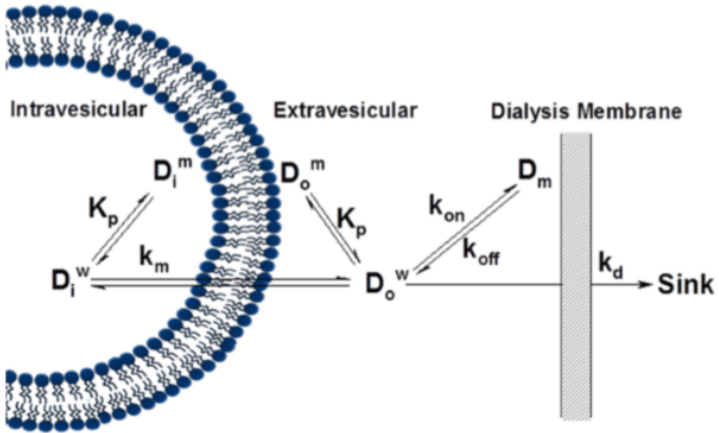Liposome Drug Release Kinetics
Creative Biostructure has professional liposomes techniques and expertise to support the application of liposomes in drug delivery system. In addition to the customized production of liposomes, we offer comprehensive analyses and evaluation, as part of our drug efficacy service, to facilitate drug release kinetic studies.
Why drug release kinetics is important to liposome?
Liposomes has become a powerful tool in drug delivery. To maximize the effectiveness of encapsulated drug in liposomes, premature drug release should be avoided at all cost in order to reduce drug loss during systemic circulation. More importantly, release of drug locally at the site of action is the key to achieve optimal efficacy and to reduce toxicity. Thus, the kinetics of drug release from liposomes is a critical factor to be considered in liposome formulation design, and also serves as a prerequisite to establish the correlation between in vitro and in vivo studies.
 Figure 1. Schematic depicting the ionization and binding equilibria along with transport pathways representing the study of drug release kinetics from liposomes by the dynamic dialysis method. Diw and Dim are the intravesicular aqueous and membrane bound drug concentration, respectively; Dow and Dom are the extravesicular aqueous and membrane bound drug concentration, respectively. Dm is the dialysis membrane bound drug concentration. km and kd are the rate constants for permeation across the bilayer membrane and dialysis membrane, respectively. kon and koff are the apparent association and dissociation constants for the binding of drug to the dialysis membrane. (Molecular Pharmaceutics, 2013)
Figure 1. Schematic depicting the ionization and binding equilibria along with transport pathways representing the study of drug release kinetics from liposomes by the dynamic dialysis method. Diw and Dim are the intravesicular aqueous and membrane bound drug concentration, respectively; Dow and Dom are the extravesicular aqueous and membrane bound drug concentration, respectively. Dm is the dialysis membrane bound drug concentration. km and kd are the rate constants for permeation across the bilayer membrane and dialysis membrane, respectively. kon and koff are the apparent association and dissociation constants for the binding of drug to the dialysis membrane. (Molecular Pharmaceutics, 2013)
Liposome drug release kinetics test methods
Dynamic dialysis is one of the most commonly used methods for the determination of release kinetics from liposomes by monitoring the drug concentration in the receiver solution or the disappearance of drug from the donor solution. The drug is firstly released from the liposomes into the donor solution contained in the dialysis bag. Subsequently, the drug can diffuse through the dialysis bag to the receiver solution.
Franz cell diffusion between the donor and receptor compartments is another approach to study drug release kinetics. Similar as the dynamic dialysis, synthetic membranes are used here instead of dialysis tubes to let drug diffuse through, then monitor drug concentration changes for kinetics analysis.
Creative Biostructure is quipped with the most up-to-date liposome technology and a comprehensive set of modern instruments to help you understand the kinetic properties of various liposome products. Our team of skilled scientists work closely with the clients to ensure the most effective implementation and ongoing outcomes for your project. Please do not hesitate to contact us for more information.
Ordering Process
References
- Sweta Modi, Bradley D. Anderson. (2013) Determination of drug release kinetics from nanoparticles: overcoming pitfalls of the dynamic dialysis method. Mol. Pharmaceutics, 10, 3076−3089.
- Eliana Leo, Riccardo Cameroni, Flavio Forni. (1999) Dynamic dialysis for the drug release evaluation from doxorubicin–gelatin nanoparticle conjugates. International Journal of Pharmaceutics 180: 23–30.
- Kyle D. Fugit, Bradley D. Anderson. (2014) Dynamic, nonsink method for the simultaneous determination of drug permeability and binding coefficients in liposomes. Mol Pharm. 11: 1314–1325.

